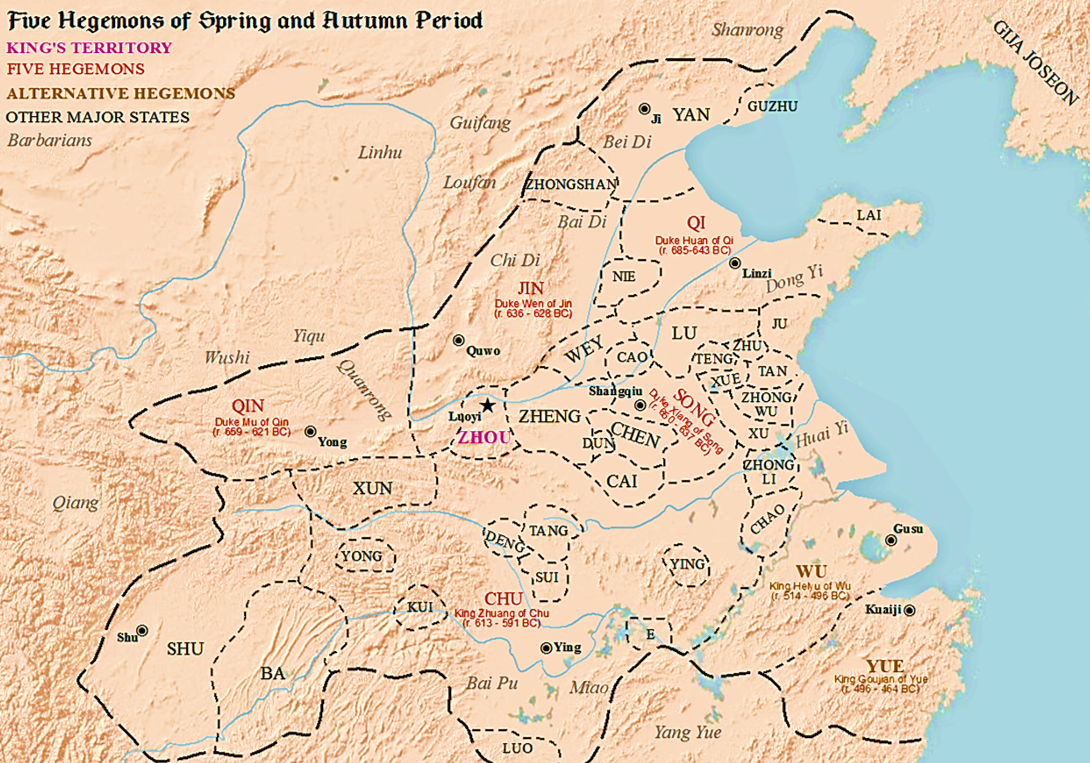|
Duke Gong Of Cao
Duke Gong of Cao (? – 618 BCE) () was the seventeenth ruler of the vassal State of Cao during the Chinese Spring and Autumn period (770 – 475 BCE). Born Ji Xiang (姬襄), he was the son of Duke Zhao of Cao. History In 637 BCE, during the exile of Chong’er, son of Duke Xian of Jin, Duke Gong heard that Chong’er suffered from fused ribs in a parallel way that makes it look like one rib bone(which was considered as the sign of saints in ancient times) and wanted to see for himself. Chong’er caught Duke Gong spying on him whilst he bathed and described the Duke as a man of “unbelievable rudeness”.Zuo Zhuan, “The Death of Chong’er”《晉公子重耳之亡》 After Chong’er became Duke Wen of Jin and one of the Five Hegemons, in 632 BCE, he used Duke Gòng's previous rudeness as an excuse to overthrow the State of Cao. Duke Gòng was captured by the State of Jin but later released. After Duke Gong of Cao died in 618 BCE, his son Duke Wen of Cao became ruler ... [...More Info...] [...Related Items...] OR: [Wikipedia] [Google] [Baidu] |
Cao (state)
The State of Cao () was a vassal state in China during the Zhou dynasty (1046–221 BC). The state was founded sometime in the 11th century BC by (d. 1053 BC), a son of King Wen of Zhou and younger brother of King Wu of Zhou. With its capital at Taoqiu (陶丘), the State of Cao covered roughly the area of modern-day Dingtao County, Shandong Province. It was located on the flat country of the North China Plain about 50 miles east of the point where the current course of the Yellow River changes from east to north-east. To the northwest was Wey, to the northeast Lu and to the southeast Song. History As a result of the Cao's relative weakness, later generations wrote few records on events concerning the state's history. The only major event recorded in the Records of the Grand Historian during the Western Zhou dynasty (1046 – 770 BC) was in 826 BC when Count You of Cao was killed by his younger brother Count Dai of Cao.Sima Qian, ''Records of the Grand Historian'' At th ... [...More Info...] [...Related Items...] OR: [Wikipedia] [Google] [Baidu] |
Spring And Autumn Period
The Spring and Autumn period () was a period in History of China, Chinese history corresponding roughly to the first half of the Eastern Zhou (256 BCE), characterized by the gradual erosion of royal power as local lords nominally subject to the Zhou exercised increasing political autonomy. The period's name derives from the ''Spring and Autumn Annals'', a chronicle of the state of Lu between 722 and 481 BCE, which tradition associates with Confucius (551–479 BCE). During this period, local polities negotiated their own alliances, waged wars against one another, up to defying the king's court in Luoyang, Luoyi. The gradual Partition of Jin, one of the most powerful states, is generally considered to mark the end of the Spring and Autumn period and the beginning of the Warring States period. The periodization dates to the late Western Han (). Background In 771 BCE, a Quanrong invasion in coalition with the states of Zeng (state), Zeng and Shen (state), Shen— ... [...More Info...] [...Related Items...] OR: [Wikipedia] [Google] [Baidu] |
Duke Zhao Of Cao
Duke is a male title either of a monarch ruling over a duchy, or of a member of royalty, or nobility. As rulers, dukes are ranked below emperors, kings, grand princes, grand dukes, and above sovereign princes. As royalty or nobility, they are ranked below grand dukes and above or below princes, depending on the country or specific title. The title comes from French ''duc'', itself from the Latin ''dux'', 'leader', a term used in republican Rome to refer to a military commander without an official rank (particularly one of Germanic or Celtic origin), and later coming to mean the leading military commander of a province. In most countries, the word ''duchess'' is the female equivalent. Following the reforms of the emperor Diocletian (which separated the civilian and military administrations of the Roman provinces), a ''dux'' became the military commander in each province. The title ''dux'', Hellenised to ''doux'', survived in the Eastern Roman Empire where it continued in sever ... [...More Info...] [...Related Items...] OR: [Wikipedia] [Google] [Baidu] |
Chinese Ancestral Name
Chinese surnames are used by Han Chinese and Sinicized ethnic groups in Greater China, Korea, Vietnam and among overseas Chinese communities around the world such as Singapore and Malaysia. Written Chinese names begin with surnames, unlike the Western tradition in which surnames are written last. Around 2,000 Han Chinese surnames are currently in use, but the great proportion of Han Chinese people use only a relatively small number of these surnames; 19 surnames are used by around half of the Han Chinese people, while 100 surnames are used by around 87% of the population. A report in 2019 gives the most common Chinese surnames as Wang and Li, each shared by over 100 million people in China. The remaining eight of the top ten most common Chinese surnames are Zhang, Liu, Chen, Yang, Huang, Zhao, Wu and Zhou. Two distinct types of Chinese surnames existed in ancient China, namely ''xing'' () ancestral clan names and ''shi'' () branch lineage names. Later, the two terms wer ... [...More Info...] [...Related Items...] OR: [Wikipedia] [Google] [Baidu] |
Duke Wen Of Jin
Duke Wen of Jin (697–628BC), personal name Ji Chong'er, was duke of the Jin state from 636 BC to 628 BC. He was exiled from Jin for approximately 20 years before finally assuming the throne and rapidly leading Jin to hegemony over the other Chinese states of his time. Duke Wen is a figure in numerous Chinese legends, including those about his loyal courtier Jie Zhitui, whose death is said to have inspired China's Cold Food Festival and Qingming Festival. Names "Duke Wen of Jin" is a posthumous name bestowed on him as part of his family's ancestral veneration. It literally means the "Cultured Duke of Jin". Duke Wen's given name was Chong'er. His clan name was Ji. Life Early life Prince Chong'er was born to Duke Xian of Jin in 697 BC. The '' Zuo Zhuan'' notes that "his ribs were all grown together," a sign of strength and leadership. Chong'er's half-brothers included Shensheng and Xiqi. While Shensheng was the original crown prince, in his later years Duke Xian ... [...More Info...] [...Related Items...] OR: [Wikipedia] [Google] [Baidu] |
Duke Xian Of Jin
Duke Xian of Jin (), personal name Ji Guizhu, was a ruler of the Jin state, reigning for 26 years. He moved the capital from Quwo (曲沃) to Jiang (絳). He was named after the Rongdi (戎狄) leader Guizhu (詭諸), whom his father and predecessor, Duke Wu, captured alive. During his reign, the Jin state became one of the most powerful and largest states due to his conquests of many small neighboring states. He is also renowned for the slaughter and exile of many ducal family members of Jin and for favoring one of his concubines, Li Ji. Rise to power When he ascended the throne, Duke Xian of Jin and the duke of Guo visited King Hui of Zhou and they were given rewards which resulted to the increase of their popularity throughout the states. He also adopted a strategy that his official, Shi Wei (士蒍), suggested which involves the slaughter and exile of almost all the royal family members of Jin to ensure that the throne of Jin will always be held by one of his descendants. ... [...More Info...] [...Related Items...] OR: [Wikipedia] [Google] [Baidu] |
Zuo Zhuan
The ''Zuo Zhuan'' ( zh, t=左傳, w=Tso Chuan; ), often translated as ''The Zuo Tradition'' or as ''The Commentary of Zuo'', is an ancient Chinese narrative history traditionally regarded as a commentary on the ancient Chinese chronicle the '' Spring and Autumn Annals''. It comprises 30 chapters covering the period from 722 to 468BC, and focuses mainly on political, diplomatic, and military affairs from that era. For many centuries, the ''Zuo Zhuan'' was the primary text through which educated Chinese learned their ancient history. The ''Zuo Zhuan'' does not simply explain the wording of the ''Spring and Autumn Annals'', but rather expounds upon its historical background with rich and lively accounts of the history and culture of the Spring and Autumn period (771476 BC). The ''Zuo Zhuan'' is the source of more Chinese sayings and idioms than any other classical work, and its concise, flowing style served as a paragon of elegant Classical Chinese. Its tendency toward thi ... [...More Info...] [...Related Items...] OR: [Wikipedia] [Google] [Baidu] |
Five Hegemons
The Five Hegemons (), also referred to as the Five Hegemons of the Spring and Autumn period (), refers to several especially powerful rulers of Chinese states of the Spring and Autumn period of Chinese history (770–476 BCE), sometimes alternatively referred to as the "Age of Hegemons". There are various lists of five rulers of those certain states which rose to power over the other states of this time period, states which were also formed during the period of dissolution of a once real and strong central state, namely the empire of the Zhou dynasty. The Hegemons mobilized the remnants of the Zhou empire, according to shared mutual political and martial interests. An especially prominent Hegemon was Duke Huan of Qi. Pronunciation and meaning In ancient Chinese, (Old Chinese: ; Pinyin: ) '' has a similar meaning and pronunciation to (Old Chinese: ; Pinyin: ), which means 'the eldest son born to the principal wife in a family', or 'senator'. Both and can be translated as th ... [...More Info...] [...Related Items...] OR: [Wikipedia] [Google] [Baidu] |
Records Of The Grand Historian
The ''Shiji'', also known as ''Records of the Grand Historian'' or ''The Grand Scribe's Records'', is a Chinese historical text that is the first of the Twenty-Four Histories of imperial China. It was written during the late 2nd and early 1st centuries BC by the Han dynasty historian Sima Qian, building upon work begun by his father Sima Tan. The work covers a 2,500-year period from the age of the legendary Yellow Emperor to the reign of Emperor Wu of Han in the author's own time, and describes the world as it was known to the Chinese of the Western Han dynasty. The ''Shiji'' has been called a "foundational text in Chinese civilization". After Confucius and Qin Shi Huang, "Sima Qian was one of the creators of Imperial China, not least because by providing definitive biographies, he virtually created the two earlier figures." The ''Shiji'' set the model for all subsequent dynastic histories of China. In contrast to Western historiographical conventions, the ''Shiji'' does no ... [...More Info...] [...Related Items...] OR: [Wikipedia] [Google] [Baidu] |



